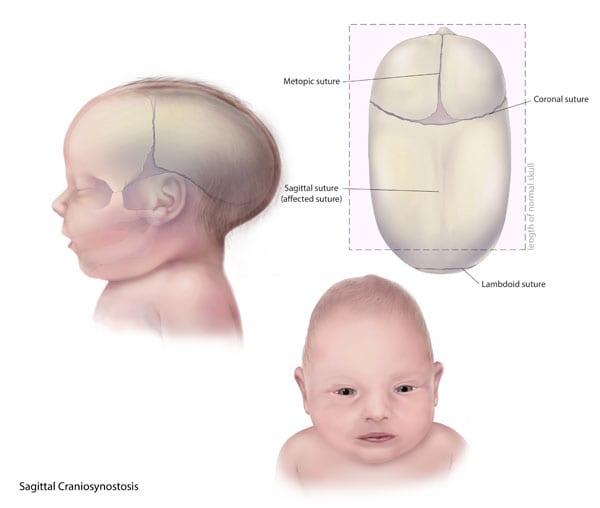Craniosynostosis: Symptoms, Causes & Treatment
What are the symptoms of craniosynostosis?
Craniosynostosis is a condition in which one or more of the fibrous sutures in an infant’s skull prematurely fuses, which can affect the shape of the head and potentially lead to developmental issues. The symptoms of craniosynostosis can vary depending on the type and severity of the condition, but may include:
- Abnormal head shape: One of the most common signs of craniosynostosis is an abnormal head shape, which may be noticeable at birth or become more apparent as the child grows. The head may appear misshapen, with a flattened or pointed appearance.
- Visible or palpable sutures: In some cases, the affected suture(s) may be visibly or palpably fused, leading to an abnormal ridge or absence of the suture line.
- Increased head circumference: In infants with craniosynostosis, the head circumference may be larger than expected for their age and developmental stage.
- Developmental delays: Some infants with craniosynostosis may experience developmental delays, such as delays in motor skills or speech development. These delays may be due to increased intracranial pressure caused by the abnormal skull growth.
- Raised intracranial pressure: In severe cases of craniosynostosis, increased intracranial pressure can occur, leading to symptoms such as irritability, vomiting, and changes in behavior.
- Vision problems: Craniosynostosis can sometimes affect the development of the eye sockets, leading to vision problems such as strabismus (crossed eyes) or difficulty focusing.
It’s important to note that not all infants with craniosynostosis will experience symptoms, and the severity of symptoms can vary widely. If you suspect that your child may have craniosynostosis, it’s important to consult with a healthcare provider for a proper diagnosis and appropriate management. Early diagnosis and treatment can help prevent complications and ensure optimal outcomes for affected children.
What are the causes of craniosynostosis?
Craniosynostosis occurs when one or more of the fibrous sutures in an infant’s skull fuse prematurely, which can affect the growth and shape of the head. The exact cause of craniosynostosis is not always known, but several factors may contribute to its development, including:
- Genetics: Craniosynostosis can run in families, suggesting a genetic component. Some genetic syndromes, such as Apert syndrome, Crouzon syndrome, and Pfeiffer syndrome, are known to be associated with craniosynostosis.
- Spontaneous mutations: In some cases, craniosynostosis may occur due to spontaneous mutations in the genes responsible for skull development.
- Environmental factors: Some environmental factors, such as maternal smoking or certain medications taken during pregnancy, may increase the risk of craniosynostosis.
- Positional molding: Mild forms of craniosynostosis can occur due to pressure on the baby’s head in the womb or from positioning after birth. This is known as positional molding and is not typically associated with complications.
- Unknown factors: In many cases, the exact cause of craniosynostosis is not known, and it may occur without a clear genetic or environmental cause.
It’s important to note that craniosynostosis is not caused by the way a baby is positioned in the womb or by anything the mother did during pregnancy. If you are concerned about your child’s head shape or development, it’s important to consult with a healthcare provider for a proper evaluation and diagnosis. Early diagnosis and treatment can help prevent complications and ensure optimal outcomes for affected children.
What is the treatment for craniosynostosis?
The treatment for craniosynostosis depends on the severity of the condition and the age of the child. Treatment may involve observation, helmet therapy, or surgery.
- Observation: In some cases, especially if the craniosynostosis is mild and not causing any symptoms, the healthcare provider may recommend regular monitoring to see if the condition improves on its own.
- Helmet therapy: For infants with mild craniosynostosis and a relatively normal head shape, helmet therapy may be recommended. This involves wearing a custom-fitted helmet that helps to reshape the skull as the baby’s head grows. Helmet therapy is most effective when started early, typically before six months of age.
- Surgery: Surgery is often recommended for more severe cases of craniosynostosis or if the condition is causing symptoms such as increased intracranial pressure. The goal of surgery is to release the fused suture(s) and reshape the skull to allow for normal brain growth. The timing and type of surgery depend on the specific type of craniosynostosis and the age of the child.
Surgery for craniosynostosis is typically performed by a pediatric neurosurgeon or craniofacial surgeon and may involve open cranial vault reconstruction or minimally invasive endoscopic techniques. The specific approach will depend on the child’s age, the severity of the craniosynostosis, and other factors.
After surgery, the child may need to wear a helmet for a period of time to help shape the skull as it continues to grow. Regular follow-up appointments with a healthcare provider are important to monitor the child’s progress and ensure optimal outcomes.




